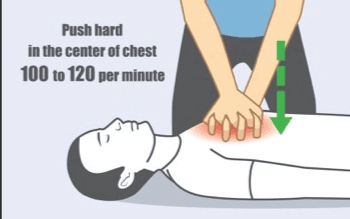
A study by the U.S. Army showed the first five to seven minutes of Compression Only CPR showed no difference in the amount of oxygen in the blood stream of a cardiac arrest victim as opposed to giving mouth to mouth resuscitation.
In the 1970’s we were taught to give “two full breaths”. This often resulted in the patient regurgitating due to excess air going to the stomach. The sphincter muscles in the esophagus relax in an unconscious patient thus there is nothing holding back the contents of the stomach. Over pressurization of the stomach often resulted in the contents being forced out to the mouth.
Current Compression Only CPR eliminates this concern.
Some elements to consider. When a patient suffers a Sudden Cardiac Arrest (SCA), the body still has oxygen in about 50% of the blood. Use it!
When we inhale a breath, we take in about 20% oxygen. When we exhale, we exhaust about 16% - 17% oxygen. Compression Only CPR allows the patient to take in the 20% oxygen. Mouth to mouth only gives the patient about 16%-17% oxygen. A 25% difference! The only difference may be in the volume. Bystanders may tend to over inflate the lungs.
A healthy adult heart only pumps about 1 ½ - 2 ounces of blood out of the hearts with each contraction. A damaged heart may pump less. A patient in cardiac arrest has No Blood Pressure unless someone can manually stimulate the heart to pump blood to the body.
Studies show brain damage starts in as little as four minutes. Manual compression of the heart and lungs can dramatically extend the survivability of the patient. Cardiac arrest stops the flow of blood and oxygen to the body.
You must become the patient’s heart!
When a bystander compresses the heart and lungs between the sternum (breastbone) and the spine, it forces air out of the lungs and heart. Upon release of the downward pressure, air returns to the lungs and blood returns to the heart and this is called recoil.
These compressions require about 40 lbs. of pressure to compress the heart and lungs a minimum of two inches deep into the chest for an adult, 1 1/2 inches for a child or 1/3 to ½ of the depth of the chest cavity.
The point to push on is one finger width above where the ribs meet (Angle of Luis). Compressions are best when the rescuer “locks” their wrist, elbow and shoulder to make a straight line. The ball of the hand should be directly over the point one finger above where the ribs come together.
Push down a minimum of two inches to compress the heart and lungs. Compressions should simulate a perfect sine wave, equal up and equal down, maximizing the distribution of blood to the lungs and out to the body. Equal up allows the heart to refill.
The rate of compressions should be not less than 100 compressions per minute but not more than 120. If you need music to keep the beat, compress to the song Staying Alive by the Bee Gees. Adrenalin can cause bystanders people to do compressions at too fast a rate. Compression rates over 140 per minute are detrimental, not allowing the heart to refill adequately.
Mike McGee is a Starting Hearts Associate and an Instructor Trainer for American Red Cross, American Heart Association and the Health and Safety Institute. He Retired from Vail, Colorado Fire and Emergency Services after 38 years and was with Colorado Mountain College Adjunct Faculty for 27 years. He brings a level of hands-on knowledge to our organization like no other and we are so fortunate to have him as part of our experienced Starting Hearts team.
